The Icelandic road system is pretty simple, yet very interesting. And so are most of the Icelandic roads. Stunningly beautiful, yet sometimes pretty difficult to drive through.
Contents
Important read: How to choose the proper car for Iceland.
Icelandic road system explained
In the most simplified words possible – the more digits the road contains, the more difficult it is 🙂 If the road doesn’t even have a number, then it’s probably even the most difficult and unmaintained one.
The ring road
The ring road – the road no. 1. This is the main and the most famous road which leads around the entire Iceland. In good weather, you may drive it in any car.

Somewhere on the ring road.
The 2-digit roads
The two-digit roads, e.g. 54. These are the turns/detours from the ring road. Still paved and well-maintained roads. Sometimes may be steeper and narrower (e.g. in Westfjords). In winter, it’s highly recommended to drive a 4×4 car on them.

Road 60, or Vestfjarðavegur in Westfjords towards Dynjandi waterfall
The 3-digit roads
The three-digit roads, e.g. 939. These are the roads of worse quality / terrain / maintenance compared to the ring road and the two-digit roads. Usually, these are “dirty” roads, where you drive on the dust, or some kind of gravel, but they are still passable with a 2-wheel drive car in good weather conditions. That can’t be said about worse weather conditions, though – and winter. Always use a 4×4 when driving in worse conditions on three-digit roads.
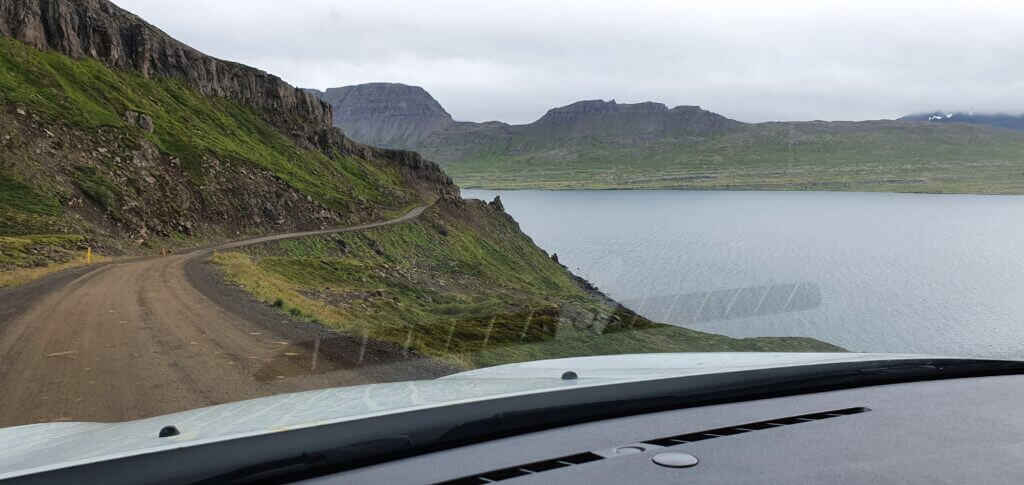
Overview of Strandavegur, a.k.a. road 643
The three-digit roads vary in quality highly. Sometimes they have a lot of potholes and washboards. Sometimes they are narrow and steep. Sometimes they are just straight, good-quality roads that are just not completely paved. The three-digit roads never contain unbridged river crossings, though.
Enjoy car rental discounts and tour discounts in Iceland for our readers.
F-roads
F-roads, e.g. F905. The most famous Icelandic roads are undoubtedly F-roads. Some are afraid about driving on them, some love them. All of you have probably read a lot about F-roads already so I’m not gonna go into general info.
Shortly, F-roads are highland roads that are too remote or too difficult to be paved or regularly maintained. Very often they contain unbridged river crossings of various sizes (though, not always, e.g. F985, F946, F347, …). F-roads may be (and often are) difficult also in many other aspects – steep, narrow, big holes, bad grip, big gravel, sharp stones, uneven ground, etc.

F899 Flateyjardalsvegur
It’s compulsory to drive the F-roads only with 4×4 cars. F-roads are also officially open only in summer (usually July and August). It’s possible to drive the F-roads also outside of summer, however, there is no winter service, which means they are not maintained and most of the time they are virtually impossible to drive on. Outside of the summer, most of the F-roads are passable only by huge super jeeps and experienced drivers. Snow is one of the biggest road dangers in Iceland. See below the section explaining the difference between “impassable”, “closed” and “no winter service” road.
F-roads also often get closed due to bad weather, bad road conditions, too much rain etc. – see the section below – road alerts and weather alerts.
Most of the car rental insurance packages also do not cover many common damages which occur on F-roads (such as damaging the undercarriage/chassis of your vehicle). For example, there is only one company – Lotus car rental – which insures you also for water damage / river crossings. No other company does this!
Luckily, there’s an external insurance provider which can insure you against everything (except river crossings) for an affordable price, which we always use when renting cars in Iceland. RentalCover gives you better coverage for a lower price compared to local insurance packages. If you are interested in more details about how car rental insurance works in Iceland, we wrote an article about how to choose the best car rental insurance in Iceland.
We also wrote a detailed list of all F-roads to help you navigate through beautiful and difficult Icelandic highland roads.
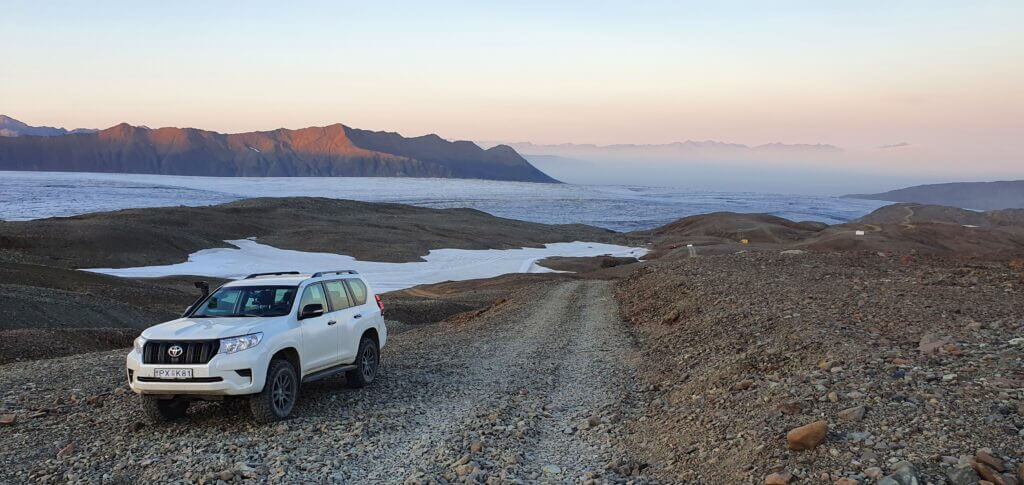
F985 Vatnajokull glacier
Dirt tracks
Dirt tracks, e.g. Krakatindur. “Dirt tracks” is not the official name. It’s a term I use for unpaved non-F-roads which are still considered to be roads and are perfectly legal to drive on (in a proper vehicle and conditions). Most of them, you will not find on Google maps. But you should find all of them on the Icelandic map Iskort.
If the road isn’t marked as a “road” on this map and it doesn’t lead to any settlement/hut then it is forbidden to drive through it and it’s considered off-road driving (see the section below).
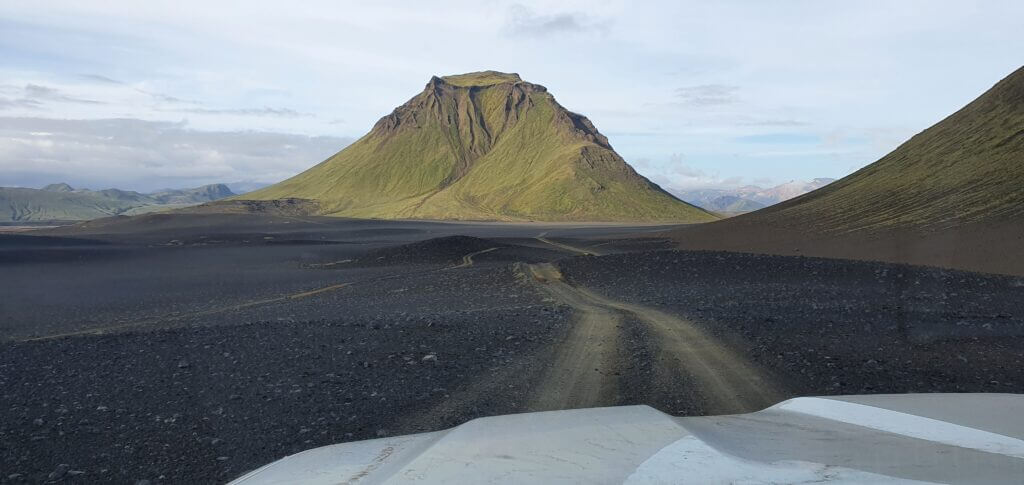
Some well-known dirt tracks in the south include the Krakatindur track (Krakatindsleið), Skaelingar track, Hungurfit track, and several more. The list is pretty long, though. We list some of the dirt tracks in our List of all F-roads. Most of these tracks do have names and if you arrive at their beginning you will find a metal or wooden sign next to it pointing towards a final destination (which is usually a hut or some locally well-known place).
These dirt tracks are the least maintained and often the most difficult Icelandic roads. Some insurance packages are not applicable at all. They are covered by RentalCover insurance packages, though. That’s why we always use RentalCover for insurance when renting cars in Iceland. These tracks are often steep, uneven, full of potholes, may contain big river crossings, there’s often no network coverage and the traffic is very scarce, meaning if anything happens, any help may be far away.

Between Skælingar track and Blautulón track to Langisjór
Moreover, many car rental companies explicitly forbid you to drive on Icelandic tracks. Even with 4×4 cars, it’s often forbidden. F-roads are allowed, but not dirt tracks. Always ask your car rental company and/or read your rental car terms and conditions! If you rent a super jeep, however, these tracks are usually allowed to drive on.
- Please, be very careful and prepare well in advance when driving dirt tracks.
- Never go during weather or road alerts.
- Don’t go outside of summer.
- Have backup plans ready, enough food and water.
- Most importantly, take a proper car – a super jeep.
- Ask someone, ideally a ranger, before going.
- Study the tracks in guides like our List of all F-roads.
- And if you are not willing to put up all these efforts, then definitely DON’T DRIVE them yourself, take a specific guided tour or a private super jeep tour!
Read our guide on how to choose the best insurance for your car rental in Iceland.
Road alerts and weather alerts
The most important thing to look at – and to begin with – are the weather and road alerts. You can find most of these summarized on the website www.safetravel.is. Weather-related alerts are also to be found on en.vedur.is. Road-related warnings are displayed on road.is.
Please always CHECK THESE FIRST. If everything is OK, then proceed with the planning of your trip further. These alerts appear all year round in various forms, so please read them daily.
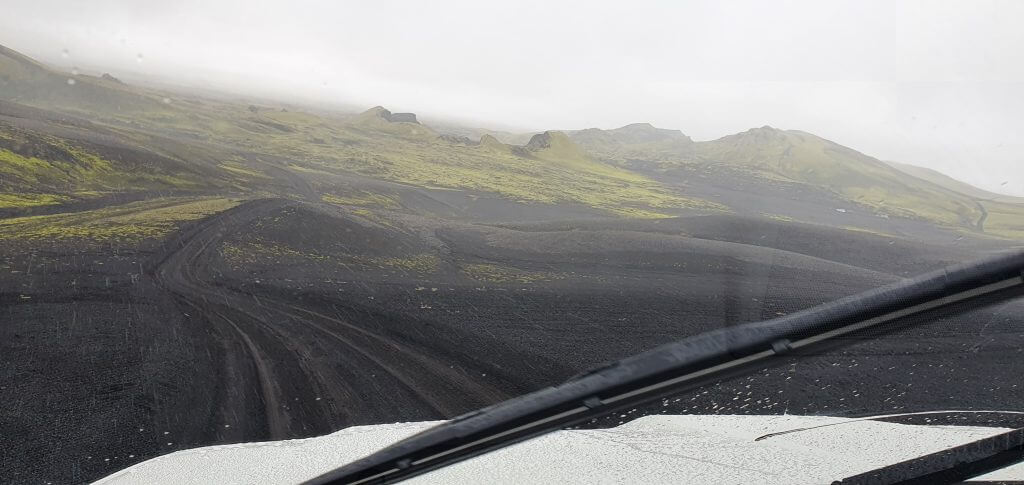
F207 around Laki craters in rainy weather
For example, during our stay in August, it rained a bit more for 3 days and some of the roads became impassable even in the middle of the summer. We planned to cross the country via F26, only to realize the day before the trip that it was marked impassable due to high water level in the Hagakvisl river. We had to change our plans, but better to change your plans than to get your 50 000 Eur worth car rental drown in the river. Or worse – to end up in the river yourself.
The other day there was a strong wind warning for the Snaefelssnes peninsula, hence we decided not to travel there. All of these warnings are useful and can help you save time, nerves, health and money.
Impassable vs. Closed vs. No winter service
This is often mistaken by visitors. Usually, it goes like this:
Tourist: “F249 is impassable.“
Icelander: “Impassable doesn’t mean closed.“
Tourist: “What? But it’s impassable, isn’t it?“
Let’s clear this up:
- Impassable – this means the road is impassable for a typical visitor with a typical 4×4 car, i.e. impassable for virtually all tourists. But not for Icelanders with a super jeep and local experience. It is NOT forbidden to drive this road. BUT, the chances are (99%) you would not be able to drive it without help. An Icelandic guide can take you here, or you can use a special convoy service or a private sit-in guide. Even they can do it only in good conditions. Please don’t drive the impassable road yourself alone, you can die.
- No winter service – this is very similar to “Impassable”, but it’s softer. No winter service means the road is NOT closed. BUT, (if this is the F-road) the chances are (50-90%) you would not be able to drive it without help. There may be 1-meter deep snow, fast-flowing unbridged rivers, or simply anything else because the road just isn’t maintained at all. Again, An Icelandic guide can take you here, or you can use a special convoy service or a private sit-in guide. Please don’t drive the “no winter service” F-road yourself alone, you can get injured. If it’s not an F-road, it’s slightly better but still can be dangerous to drive.
- Closed – this is the only official sign which really makes it illegal to drive the road. No one can drive the closed road under any circumstances.
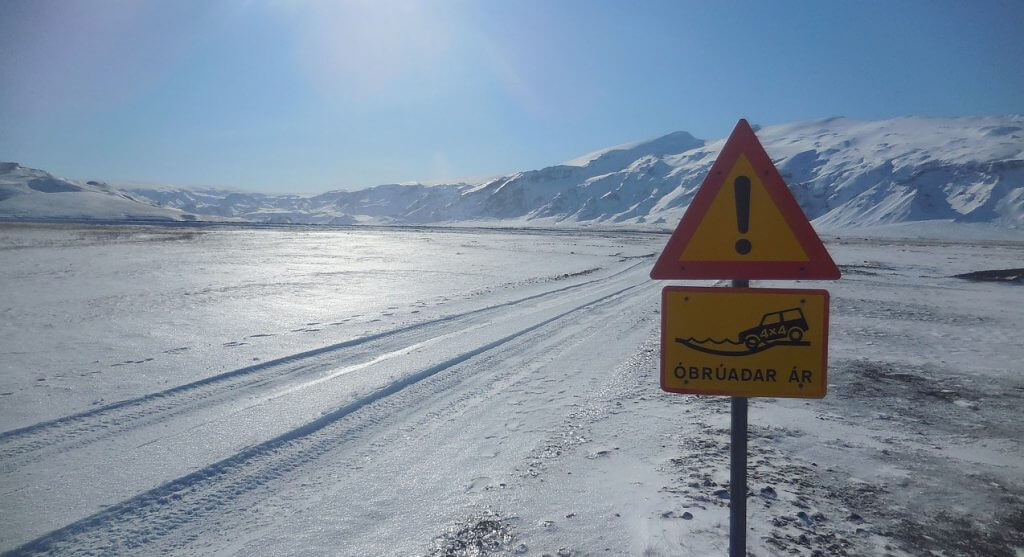
This is how an F-road in great condition looks like when it snows
Off-road driving
Off-road driving is illegal and strictly forbidden in Iceland. This is rule number one. If you drive off the road, you may get a hefty fine of several tens of thousands of Euros/Dollars. The reason is, Icelandic nature is very fragile, and if you e.g. drive through the moss, it may die completely and never grow again. But not everyone understands what off-road driving actually means.
What is off-road driving
- If you drive away from any road – be it normal road, F-road, or any official Icelandic track
- If there’s a puddle/water in the middle of the road and you drive away from the road (e.g. on a moss) to avoid it
- Look at the picture below which depicts it nicely:
What is NOT off-road driving
- Driving through a puddle in the middle of the road
- Driving on the impassable / no winter service road (if you really stick to the actual road, if not, it’s illegal driving!)
- Driving on the dirt track which is not on Google Maps and it’s not even an F-road, but it’s on Icelandic maps
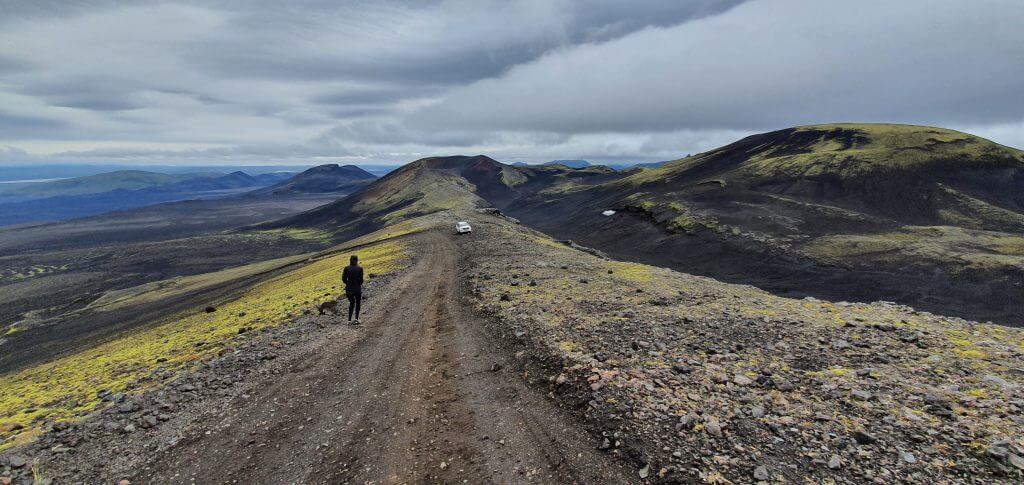
The final ascent of the Hekla track.
The main roads and F-roads are not the only legal roads to drive on in Iceland. There are also “dirt tracks”, usually a road with clear tracks and a sign pointing to their endpoint (e.g. “Hekla”). It’s OK to drive there – BUT – they are usually very difficult (more than F-roads), require a big car and you will drive there entirely on your own responsibility. Check your car rental terms, the chances are it’s forbidden to drive a dirt track unless you rented a super jeep. More on the dirt tracks above.
If there are tracks on the ground, which you cannot find on any maps, nor a local Icelandic map and the tracks don’t lead to any hut / settlement, then this is illegal off-road driving and you are forbidden to do it. Hence, a good rule of thumb is – if you can’t find the road on any map – don’t drive there!

Krakatindur track near Hekla. Watch out for your car’s ground clearance!
Free maps of Icelandic roads
The easiest and most accessible set of maps for Iceland – available also for a free offline download – is Google maps. If you find the road on Google maps, 99% of the time you may drive there (of course except for road alerts and weather alerts which Google doesn’t have). Google maps don’t have all the Icelandic roads though and aren’t entirely precise. That’s why it’s good to combine them with local Icelandic maps:
Vegasja
vegasja.vegagerdin.is/eng/ is a great, updated, official source of all regular Icelandic roads and F-roads. This is a good and precise set of local Icelandic maps. It doesn’t have dirt tracks marked on it, though.
Iskort
vefsja.iskort.is/ is probably the best set of online Icelandic maps I’ve found. They were recommended to me by my friend Haraldur – thank you for that. This map contains also almost all dirt tracks and thus is the most comprehensive Icelandic map source you may possibly find.
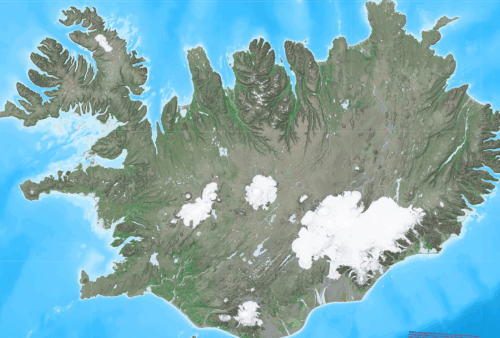
Iskort is the best local Icelandic map with all roads and dirt tracks.
Karta GPS
A great Icelandic road map mobile app is available also for free offline download. Content-wise it’s one of the greatest and you can use it as a navigation! It contains almost all of the roads, including dirt tracks and even a lot of hiking trails! Graphically, it’s maybe not that pleasant compared to the options above, but it serves its purpose well.
Videos of Icelandic roads
We tried to record all of the drives we made in Iceland recently. Subscribe to our Epic Iceland YouTube channel and get the newest videos first.
Our friend Ervin makes wonderful F-road driving videos as well. He has a pretty successful F-road YouTube channel himself, definitely follow him!

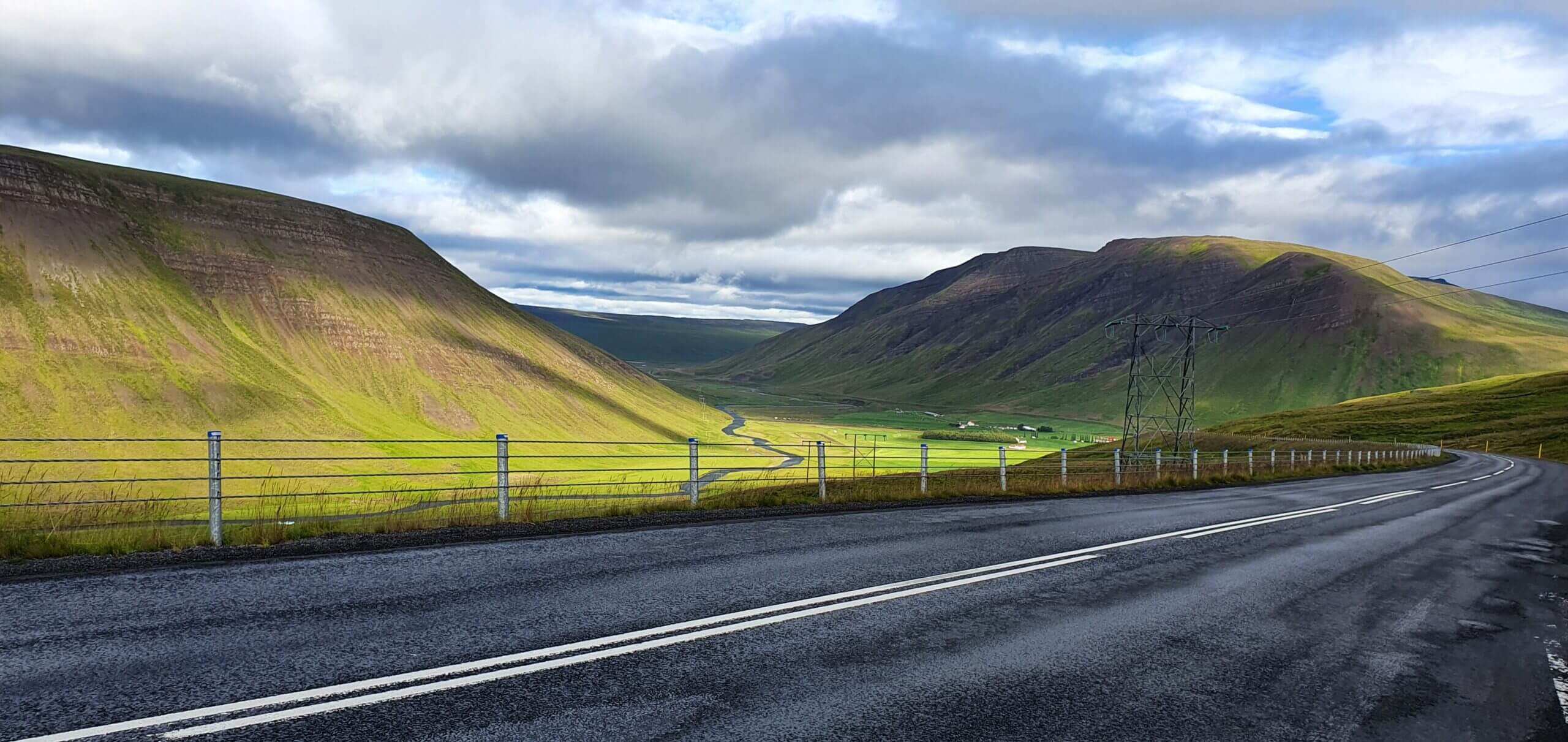

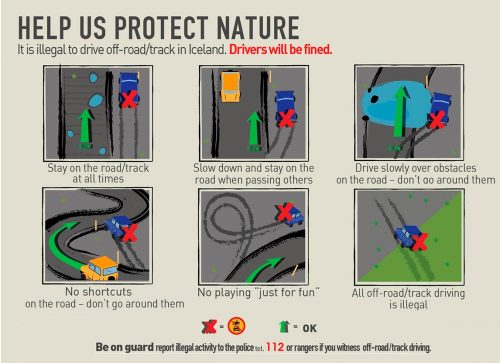

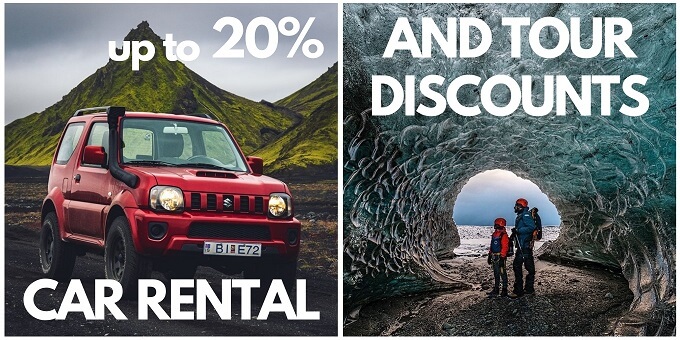
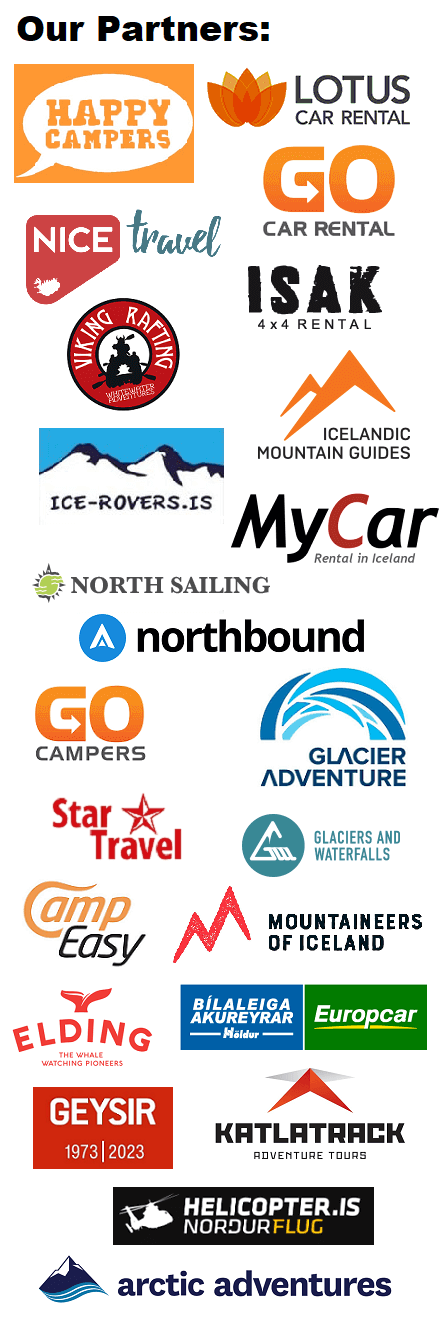

This is brilliant! I’m an avid all season driver in Iceland. Been everywhere. I always tell people to be careful regardless of the season because the weather is so unpredictable. One time, my little car blew over in the wind from the Irpirt to town. My scariest was driving the mountain road South to the East Fjords. My car started grinding, 4 x 4 and got stuck at the highest point with a drop to my left. Finally a car showed up but he didn’t stop. I was waving frantically but nope. Nothing but sheep.
This is excellent infrmation.
Hello, and first of all an immense thanks for all the info you put up on this site, it’s so thorough it’s amazing !
I’m currently planning a 16-day trip from July 1st to July 17th, and will probably take the Duster with a roof tent from Lotus Car Rental, you sold it well. One little question I have (though I’ll probably ask you a few other ones until our departure), is do you think the GPS option they offer for a small fee is worth it, what database their GPS does use, or are we covered by just using our phones plugged on the USB and Google Maps and the occasional app you listed in the article above ?
Thanks by advance !
Greetings from France
Hi Martial, thank you for your nice words 🙂
To be honest, we’ve never rented a GPS – always used Google Maps (95% of time) + where Google Maps didn’t have info, like some really remote roads, we used Karta GPS and Vefsja. I don’t think there can be anything more in a rented GPS compared to these 3 sources. I guess the main advantage is that rented GPS works also offline and doesn’t suck out your phone battery or otherwise blocks your phone usage. That’s why we always recommend downloading offline maps (which is of course possible with Google Maps and also with Karta GPS). So rented GPS is more or less for those who just don’t want to download any maps or use their phones.
By far, the best Icelandic ighlands web site information. I hace seen All the YouTube videos you posted.
I live in Iceland 6 months each year since 23 years ago and I never had such a good information like you posted. thanks/Gracias.
Thank you so much! Very appreciated!
Hi Igor!
I’m having trouble understanding the Rental Cover site, so I wondered if you could help with your expertise. I’m from Finland and coming to Iceland on the second week of May.
I can’t find any contacts from the Rental Cover site, just Log in option (but no Sign up at all), and I’d like to get an insurance for 4WD to drive around Iceland and explore also something other than the Ring Road. I would be very much surprised if they didn’t offer 4WD insurances for Finns, since we’ve got snow and everything here, and drivers shouldn’t usually be that unexperienced.
Until now I’ve only managed to find some basic insurance for “Car”, but it says they don’t cover 4WD on unsealed roads. What does that mean? That I can’t drive anywhere that’s not coated with asphalt? Would be a very strange deal to even offer.
Please help!
– Outi
Hi Outi,
RentalCover has changed this just recently. It seems like it only covers F-roads/Highlands (4×4 cars on unsealed roads) for British residents now. On normal sealed roads (i.e. single digit, double digit and triple digit roads in Iceland) everything is fully covered also for EU residents.
We will update this in our How to Choose a Car Rental Insurance article.
Thank you for pointing this out.
Hi. Was looking at The Iskort site. How do you know what the symbols mean? And which roads are gravel and which are paved?
Thanks! Looks like a great map!
Well, there’s no legend so only by experience 🙂 that’s why we typically combine/use more maps when travelling
Hello Igor, many thanks for your contribution. I would like to ask you if you think that F208 may be open/passable between 15-22th of June. What are the main constraints for that period? Thank you
Hi Guillermo and thank you!
The likelihood of F208 being open at that time is around 30-40%. Over the last year it didn’t open sooner than July 1st. This really depends on how soon summer and thawing arrives (and mud leaves the roads). The main constraints are most likely most of the F-roads might still be closed. These dates are on the borderline of them being open/closed, so it’s really like 40/60.
P.S. If you like what we do please write us a short review on Google: https://g.page/r/CaJt1bHCTbF1EBM/review and possibly copy paste it to Facebook: https://www.facebook.com/EpicIcelandReal/reviews too, it would help us a lot!
Many thanks for the clarification, then do you think it worth renting a 4×4 if I only wanted to drive the F208? maybe there are alternative/similar roads (breathtaking) specially in the south where I will be those 6 days, any recommendation? Thank you
Hi,
I have a question regarding the use of bicycle.
In early june, is it allowed or at least tolerated to go on F roads that are closed due to “thawing soil”.
And also, how likely it is that F roads are really closed instead of impassable in early june?
Kind regards,
Michel
Hi Michel, tough question 🙂 we are not realle experts in cycling around Iceland. But drop an email to [email protected], they are very friendly and will surely help you out. https://ust.is/english/?
F-roads between May and June fluctuate between Closed/Impassable based on how delicate the soil is. Most of the time it’s just impassable but not always. There’s no general rule on this.
Hello Igor,
I have been following your work for some years and recommend you to anyone going to Iceland. This is going to be my 4th trip. I’m renting a much more powerful car this time (Toyota Hilux 4×4 camper) and staying mostly in the East, so I’ve been scouring all your pages for tips and I love everything you do so much!
The iskort map is an amazing resource and now I finally understand how there are cars in the pictures of the Breiduvik mountain hut when not even the Icelandic road condition map sites showed anything drivable there! I even emailed the hut operators to ask the way there, but no one ever answered me.
QUESTION: Is there a key available somewhere for how to read the iskort map? Not everything is self-explanatory.
Thank you for all you do!
Anna
Hi Anna and thank you so much with all our hearts for your kind words!
There’s no legend available, but I’ll create one for you for free (at least the things we know) and post it here 🙂
P.S. If you like what we do please write us a short review on Google: https://g.page/r/CaJt1bHCTbF1EBM/review it would help us a lot!